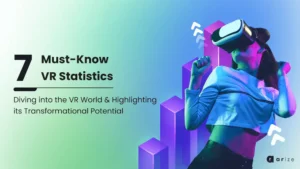The main focus of any technology is to enhance the human experience. Whether by making things easier, automating a task, or more accurate and in-depth data, technology exists to help people.
It could be argued that as well as enhancing, the main focus of AR is to educate people. AR enhances the world by adding digital elements to the real world. Those enhancements often give people help and information. While showing directions overlaid on actual streets or letting you know what a sofa would look like in your sitting room educates us by giving more details on whatever it is centered on.
So it should be no surprise that some educators already use AR technology to create engaging and insightful teaching content. When learning is immersive and experiential, studies have proven that it engages people more and increases knowledge retention dramatically.
The education sector realizes this, too, and AR (and VR) in the education space is expected to reach $19.6 billion this year (it was at $9.6 billion in 2023).
Augmenter Reality can be a helpful tool in many educational settings and can be used differently.
Classroom with AR
Teachers can enhance their explanations of subjects by utilizing AR, which visually demonstrates the learning material. And emphasizes practical application rather than solely relying on theoretical concepts. Classes incorporating AR are highly engaging, minimizing distractions and preventing children from getting bored or losing focus.
Visual learning is also a powerful instrument for developing young minds, making it easier to understand what they are being taught and remember the lessons.
It also means more opportunities to explore subjects with children without leaving the classroom, which may be difficult due to costs, location, etc.
But it is not just children that can benefit. Adults in education also get more value from AR-powered learning than traditional methods.
Augmented Reality is one of the up-and-coming digital healthcare technologies and is already revolutionizing how people educate and train their medical staff.
There are many use cases of AR technology in medical education. Some of them include:
- Creating human body models to learn anatomy in detail.
- Providing additional training opportunities with the help of simulations.
- Practicing surgeries on virtual patients.
- AR-enabled training videos to help physicians learn about the latest tools and methods.
What are the Benefits?
Engaging Learning Experience:
When students are engaged, they are more receptive, meaning they take in more and retain more information, which leads to increased knowledge retention.
Effectiveness of Learning Materials:
Learning materials are more effective when they give the students a complete representation of the subject. Relying on words in a book or 2D pictures on a screen is not always practical for specific learners.
Affordable learning:
Being able to show students AR-enhanced learning materials reduces the need to travel in the field quite as much or invest in physical aids such as books/videos. In the long run, it will be a much cheaper option.
Safe training:
For example, AR can provide a more immersive and detailed demonstration than current teaching methods regarding training for dangerous situations or handling hazardous materials. AR can provide learners with a more comprehensive education and ensure they are well-prepared without causing any harm to them.
Results
An augmented reality study was conducted in 2015 at the Ludwig-Maximilians Universität in Munich. They were teaming up AR learning activities with a traditional cadaver lab. The technology allowed students to see diagnostic images via AR. Out of the 850 first-year medical students that participated in the research, over 80% reported that the AR tool increased learning motivation. 93% said it increased their spatial understanding of anatomy.
Another study in 2012 in the International Journal of Computer Applications shared how computer science students at the Jaypee Institute of IT built an AR system to teach high school students molecular chemistry.
Their first goal was to replace the 2D representations of molecule models in books and PowerPoints with 3D models in AR. The second goal was to replace the way molecular structures were taught.
Rather than ask students to read descriptions or listen to a lecture. They were encouraged to work with the 3D models in AR and collaborate with other students. The paper concludes that students gained more knowledge of molecular structures, improved their spatial intuition, and better understood visual cues.
AR is already significantly impacting the education world, and its effects are only beginning to be seen. The future for educators is as bright as it is for the ones they teach, thanks to AR.



